UD Almeria have been sitting in the second division of Spanish football for close to six years having been relegated from La Liga in the 2014/15 season under Sergi Barjuan. Since the relegation, the highest they have managed to finish in the Segunda Division is fourth, a feat they managed in the previous campaign, but ultimately failed to secure promotion in the end.
Towards the end of the season, former Reading and Maritimo manager Jose Gomes took the reins after Mario Silva was dismissed. Gomes lost his first two games in charge but had very little time to implement his style of play and footballing philosophy within the team.
This season though, Almeria have been a much-improved side under the Portuguese coach’s guidance, and he has made them one of the most entertaining sides in the league if not the most entertaining, playing a very fluid style of football under the positional play ideology made famous by great coaches such as the former Barcelona and current Manchester City manager Pep Guardiola.
The Spanish club are sitting in third place now, seven points behind Espanyol who are top, and five behind Mallorca in second. While still having to play the league’s leaders, Almeria have a huge chance of securing automatic promotion to get back into the top-flight division, something they have failed to do for five years now, but even if they only finish in a playoff spot, La Union will certainly be favourites to be the third team to go up.
This article will be a tactical analysis in the form of a scout report of Almeria’s style of play. It will be an analysis of the strengths and weaknesses of Jose Gomes’ side, particularly observing their positional play tactics which have made them such an interesting side to watch.
Formation and typical starting lineup
Gomes has been quite consistent with his team selections this season, particularly with his backline and goalkeeper which is one of the main reasons why they are so proficient in their system of play.
The base formation has typically been a 4-2-3-1 but the shape changes depending on the situation and the space available on the pitch. Almeria can change from a 4-2-3-1 with a double-pivot, to a 4-3-3 with a single pivot, to a 3-4-3, with one of the pivot players dropping into the backline, in just a few slight movements.
This season, the 4-2-3-1 has been used in 65 percent of Almeria’s game in the Segunda Division whilst the 4-4-2 has been used in 11 percent of their matches. The remaining 24 percent is comprised of systems such as the 4-1-4-1, 4-3-3, etc.
One of the amazing aspects about Almeria this season is that they are the second-youngest squad in the league, subjectively playing some of the best football, whilst pushing for promotion. The average age of the team is 24.7, second only to Mirandes.
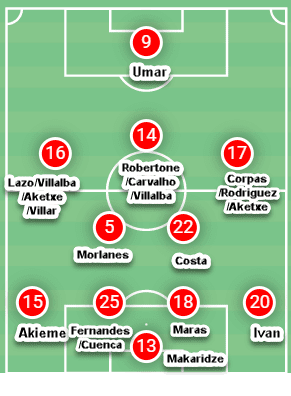
This is generally how Gomes sets out his side in their 4-2-3-1 starting formation. Giorgi Makaridze has been the starting goalkeeper all season, protecting the goal behind a back four consisting of Sergio Akieme, Ivanildo Fernandes/Jorge Cuenca, Nikola Maras, and Ivan Balliu. Fernandes and Cuenca have been battling with each other for the left centre-back berth.
In front of the backline is a double-pivot typically made up of quite a young pairing with Manu Morlanes, on loan from Villarreal, partnering alongside the highly-rated 20-year-old prospect Samuel Costa from Portugal on-loan from Braga.
The number 10 and the two wide players have been the most rotated by Gomes throughout the season. Jose Lazo, Fran Villalba, Ager Aketxe, Jose Corpas, Brian Rodriguez, and Juan Villar all battle with each other for the two available wing positions, whilst Lucas Robertone, Joao Carvalho, and Villalba fight for the number 10 position. Robertone has been Gomes’ preferred choice recently.
Former Partizan Belgrade and Roma centre-forward Sadiq Umar has started up front all season with little to no rotation as he has been their key man, chipping in with 17 goals in all competitions in the current campaign.
Build-up from the goalkeeper
Of course, staying true to the principles of positional play, Almeria play out from the back when the goalkeeper has the ball. Gomes’ side have the highest percentage of ball possession in the second division this season with 56.4 percent, while also boasting the most passes with 15,648, the most passes per 90 with an average of 443.15 per game, and the highest passing accuracy with 85.4 percent.
There are many variations of how a team structures itself in the build-up, including keeping the entire back four back to circulate the ball with the keeper.
Almeria use just three players in the first line, the two centre-backs who push wide, usually to the edge of the box, and then the goalkeeper who sits in between both men almost as a third centre-back.
Regarding the double-pivot in this phase of play, one of the pair in midfield drops behind the opposition’s first line of pressure whilst the other moves slightly higher, sometimes pushing behind the second line to always give Almeria progressive passing options in space between the lines.
The fullbacks push up 10-12 yards outside the penalty box, generally 30 yards up from the by-line, although this does fluctuate from game to game depending on the size of the pitch, the opponent on the day, and the number of players pressing them. The two wide defenders tend to stay in the same line as the pivot player who drops behind the opposition’s first line of pressure in this phase of the attack.
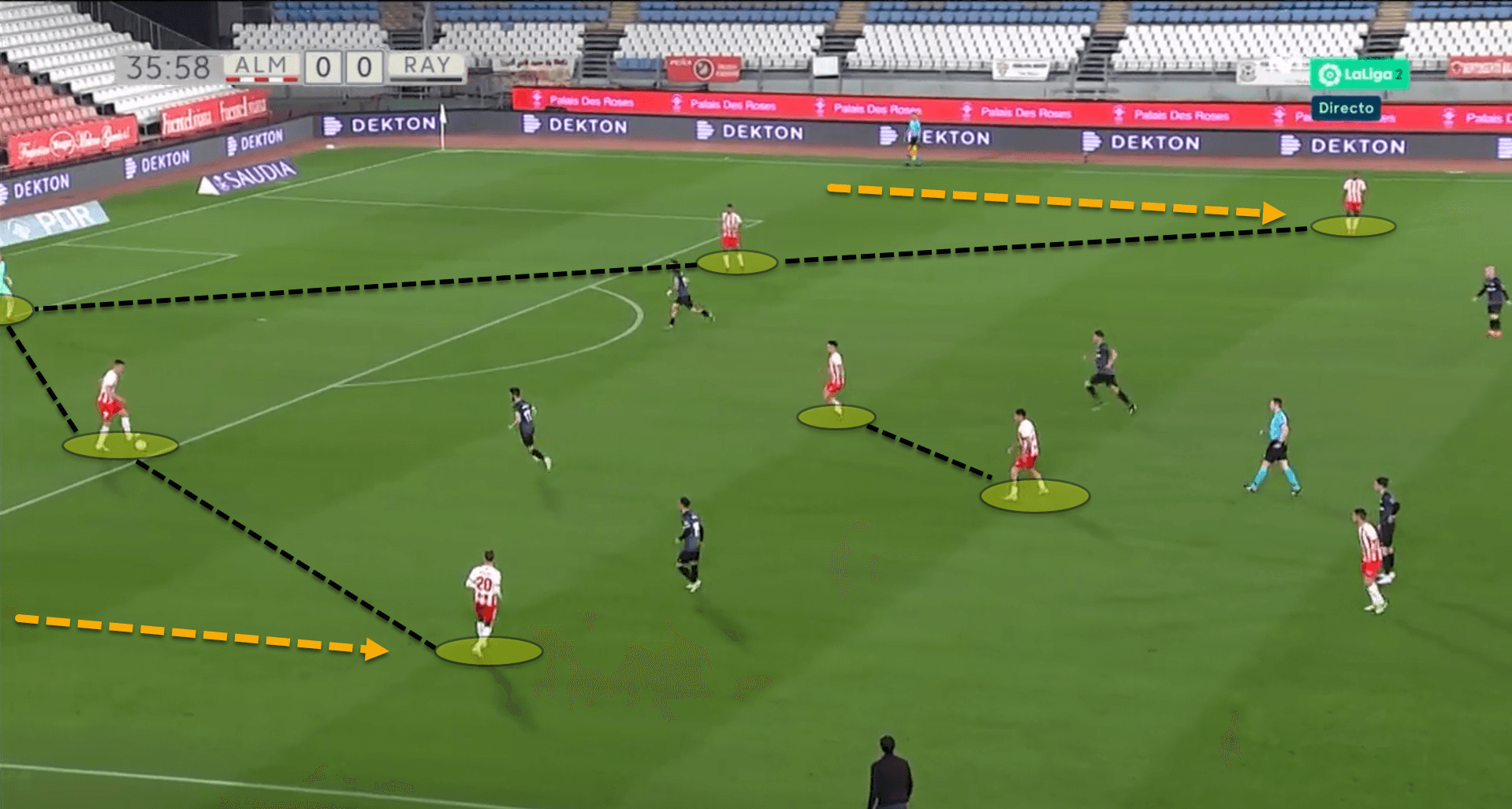
Here, we can see their build-up play structure take shape in a recent game against Rayo Vallecano. Almeria don’t need to keep the fullbacks low or drop a pivot player into the first line as they are using the goalkeeper with the two centre-backs to create a three-man line, giving them numerical superiority against the opposition’s first line of pressure with 3+1 vs 2, whilst they also have plenty of progressive passing options to allow for easy progression through the press.
Switch from a double-pivot to a single pivot
Their shape can change though and is very fluid, switching from a 4-2-3-1 to more of a 4-3-3 when playing out from their own third of the pitch. The back four hold a similar structure as well as the pivot player who drops behind the opposition’s first line of pressure. However, the other midfield pivot pushes higher up the pitch in line with the number ‘10’ to create what looks like a 4-3-3 shape.
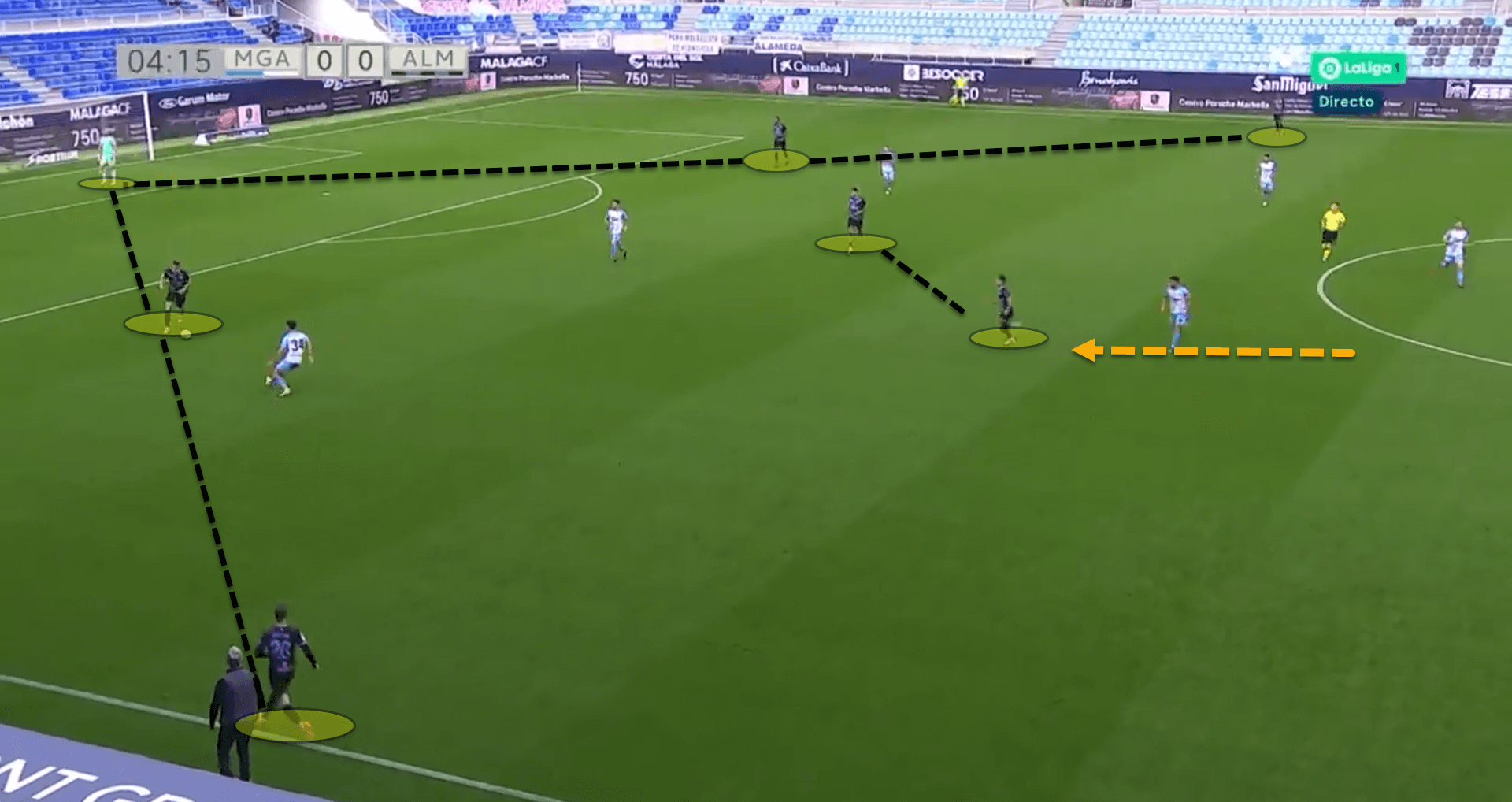
Here, we can once again see Almeria’s structure in a positional attack resembling a 4-2-3-1 with a double-pivot in midfield. However, just a few minutes later, they are building from the back once more and the shape has switched to a 4-3-3 with Morlanes pushing up behind the opposition’s third line of pressure.
This fluidity and fluctuation with their shape in possession relating to the midfield is a reaction to the opposition and their defensive shape.
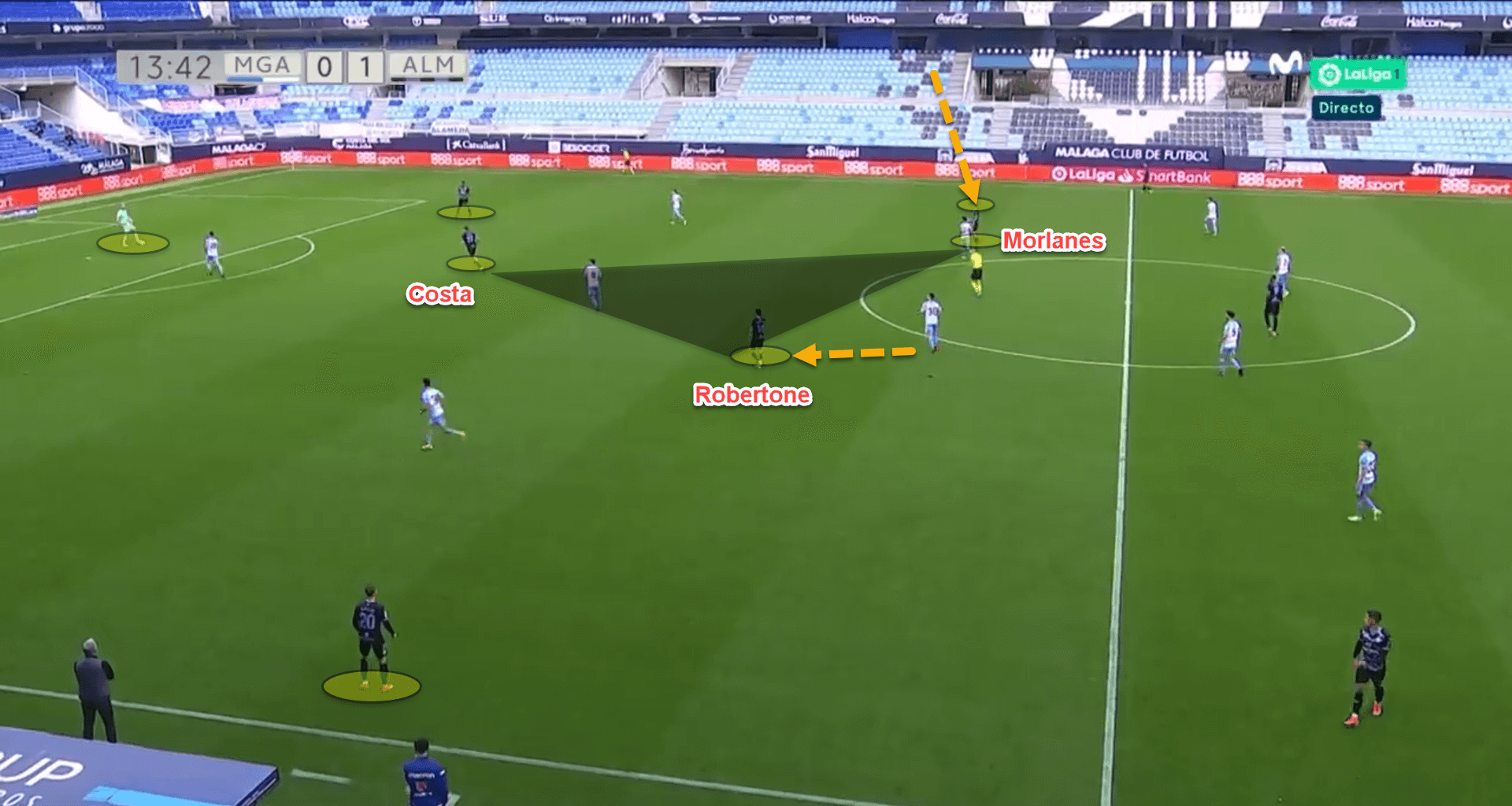
In this game, Malaga pressed with a 4-2-3-1 as we can see from the image above. Malaga’s number 10 is occupied with Costa who is positioned behind the opposition’s first line of pressure as always. Morlanes and Roberto have positioned themselves next to Malaga’s double-pivot which pins them back and prevents them from helping the front four in the press, allowing Almeria to create numerical superiority when playing out from the back to create easy progression from the goalkeeper through to the middle third of the pitch.
Almeria have the most progressive passes this season in the Segunda Division with 2,405 in total across 33 matches so far. They also average 68.11 per 90 with incredibly high accuracy of 72.8 percent.
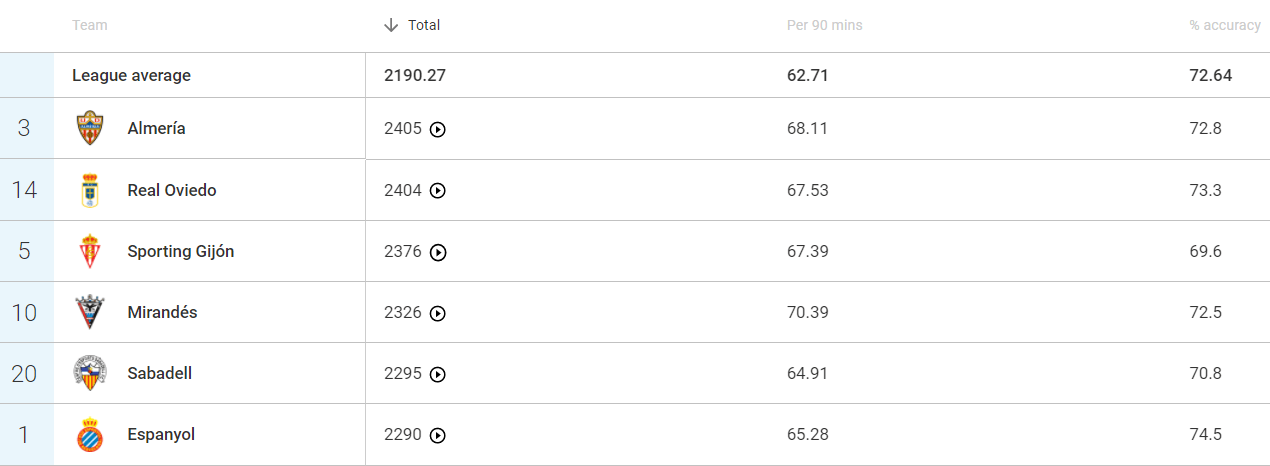
Incredibly, they have also played the highest number of smart passes in the second division of Spain this season too by quite a long way as well with an average of 7.59 per 90. A smart pass is a penetrative pass played by a player which attempts to break the opposition’s defensive line to gain a significant advantage in attack, showing that Almeria’s build-up play is very quick and they also like playing balls in behind when necessary to progress further up the pitch as quick as possible.
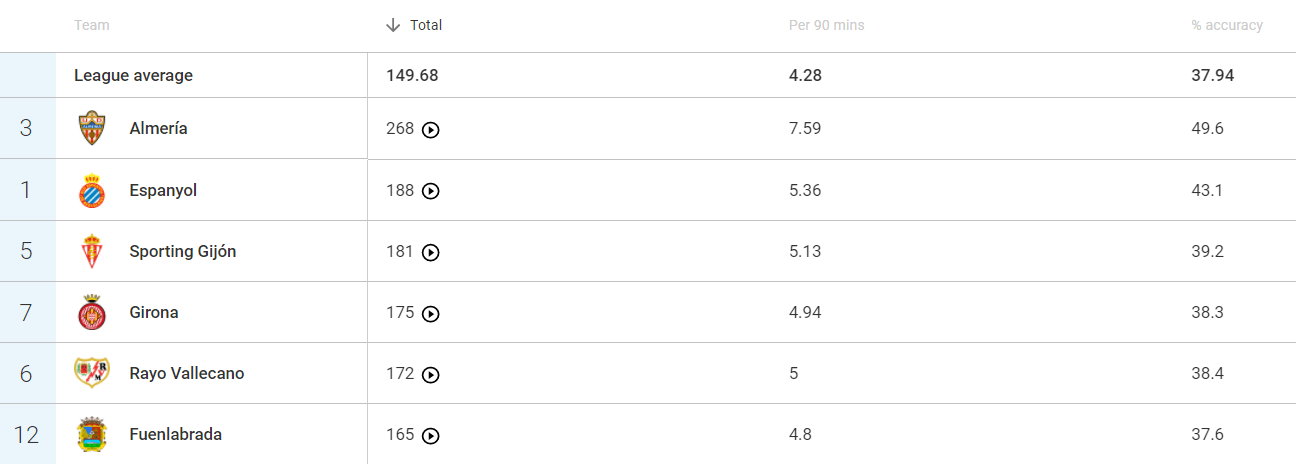
Set-up in the opposition’s half
Almeria’s structure changes as they move further up the pitch into the opponent’s half of the field, looking to create space to eventually work the ball through to the box and score.
When in a positional attack, the backline moves up towards the halfway line. This is to ensure that when they lose the ball, the team can counter-press effectively to win the ball as high up the pitch as possible, which is led by the defensive line so having the centre-backs positioned so high limits the space between them, the midfield, and the attack.
However, Gomes likes his fullbacks, usually Ivan and Akieme, to get as high up the pitch as possible. This, of course, leaves just two players at the back, the two central defenders. To regain the numerical superiority against the opposition’s first line of pressure, one of the pivot players drops between the centre-backs who push wider in order to create a 3v2. The player that is tasked with doing this is Costa when he plays.
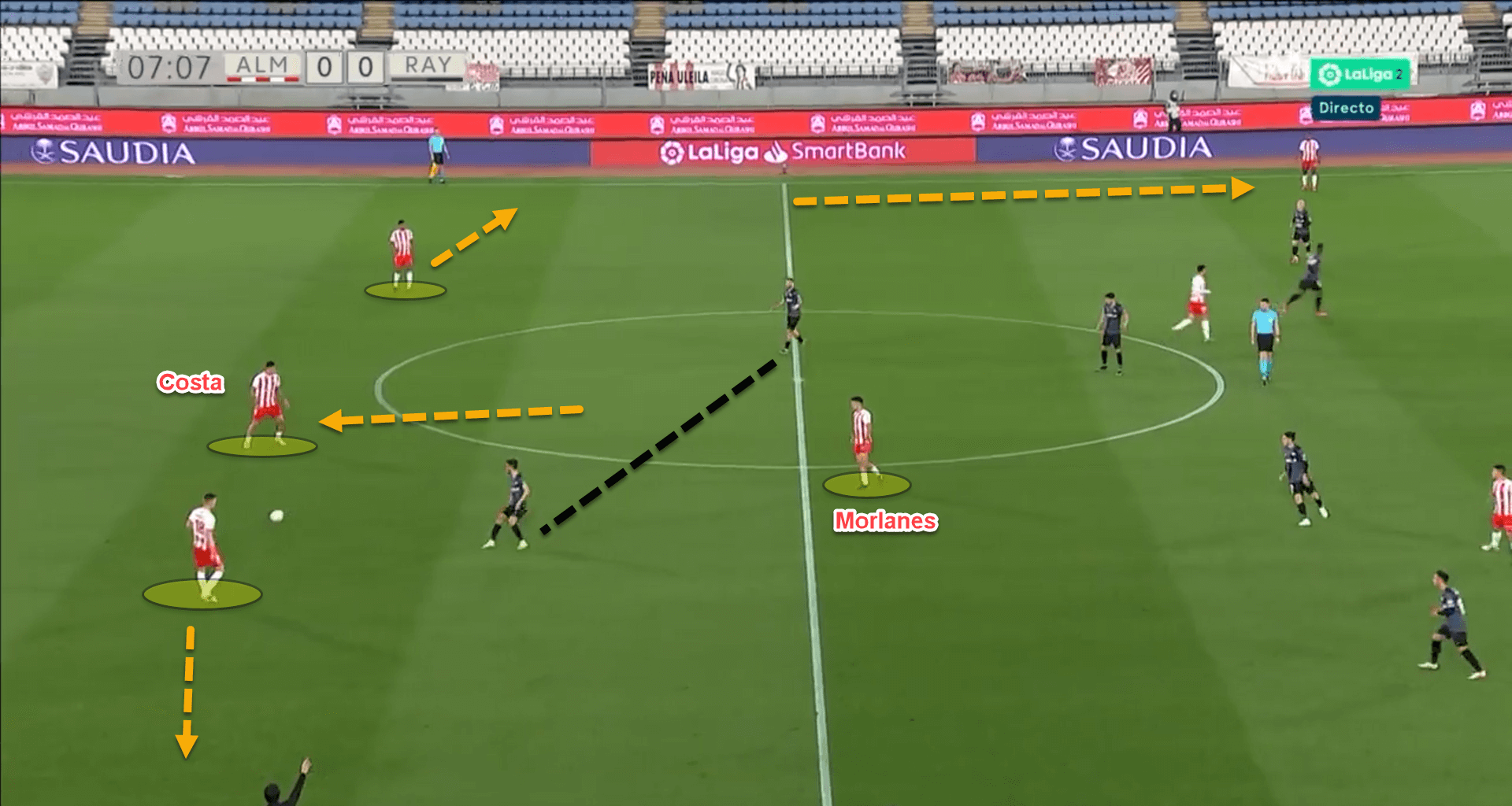
Morlanes essentially takes the role as the single pivot in these situations, sitting behind the opposition’s first line of pressure and acting as a wall pass or a passing option to progress them higher up the pitch.
Sometimes though, if Almeria are struggling with their ball progression and can’t seem to get the ball through the first or second defensive line of the opposition, the number 10 will drop deep next to Morlanes to help with the circulation and progression. This often creates a 3-4-3 or a 3-2-5 depending on the positioning of the fullbacks.
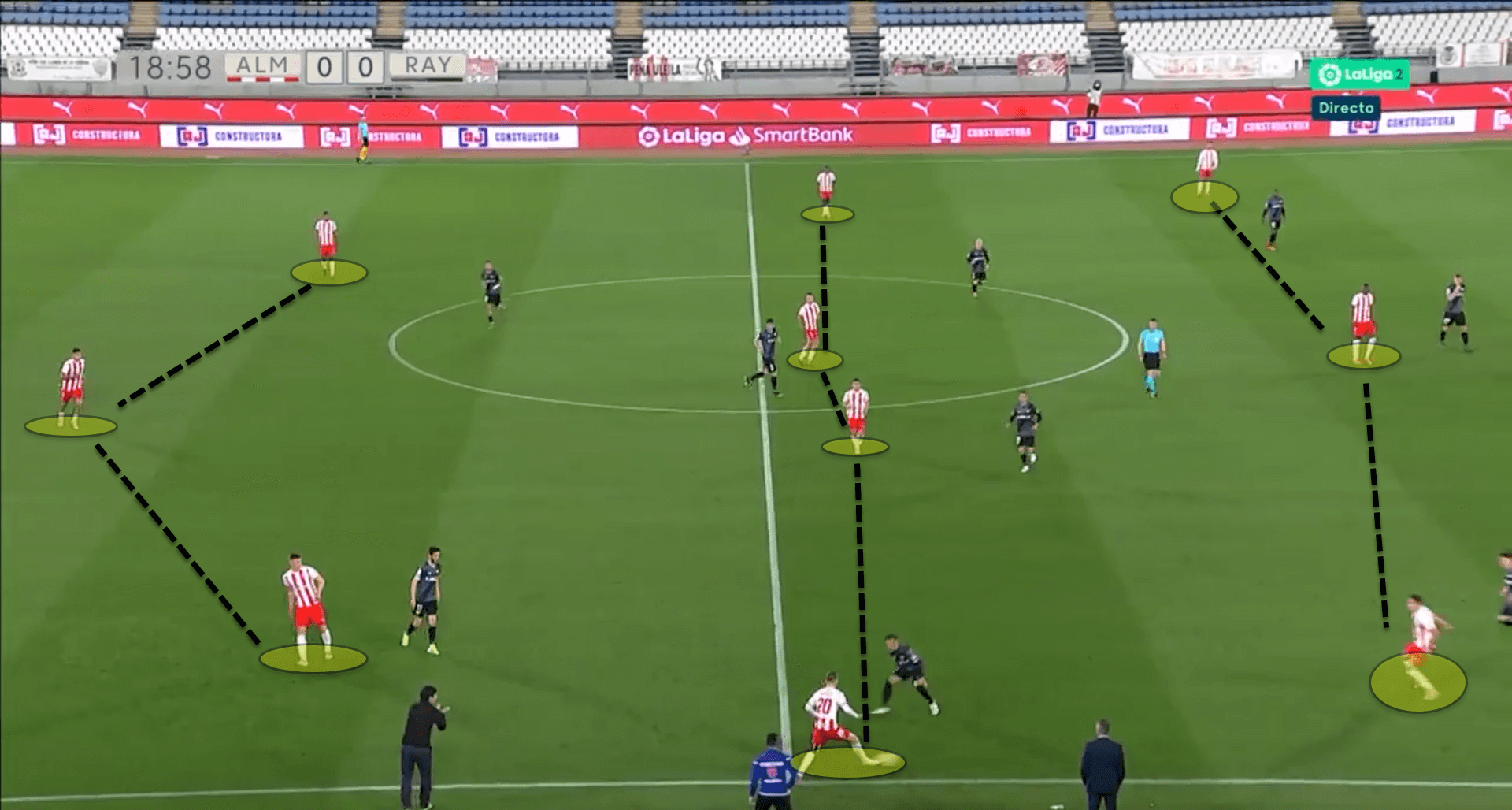
When breaking the defensive line of their opponents, Almeria like to play down the flanks, particularly the right-wing, to progress to the final third and get the ball into the box by crossing or by slipping their opponents in on goal.
We can see from the image above that La Union are playing down the right with Ivan and Corpas, attempting to use combination play to get in behind the backline. Combination play is a decent way to break through an opponent’s defensive line but can be limited in its efficiency and simple to stop.
If they are struggling to get through on the flanks, Almeria create wide overloads to give them the numerical advantage against their opponents to try and break through. The benefit of a wide overload is that it will always create a spare man on the far side who will be open for a switch of play if they are struggling to break through on the ball-side.
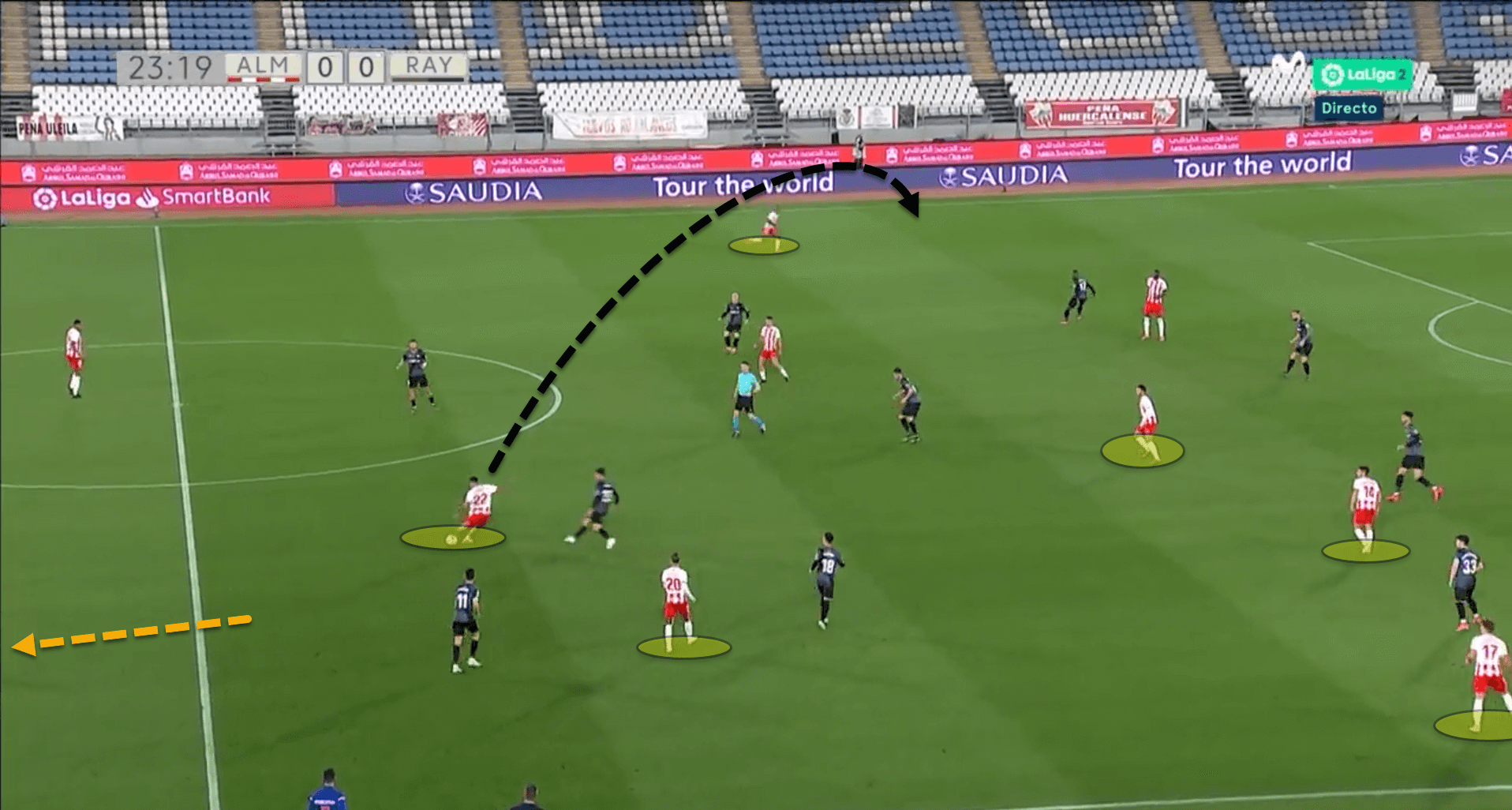
The free man is created by the wide overload because the opposition tucks their defence across to defend against the numerical advantage from the overload, but this leaves a lot of space free on the far side for a winger or a fullback. One of the main principles of positional play is to always have a free man due to having numerical superiority and having a player free in so much space can aid with easy progression to the final third.
From a visual representation displaying the direction of all of Almeria’s positional attacks from their most recent game against Rayo Vallecano, we can see that the vast majority of their attacks come from the wide areas.
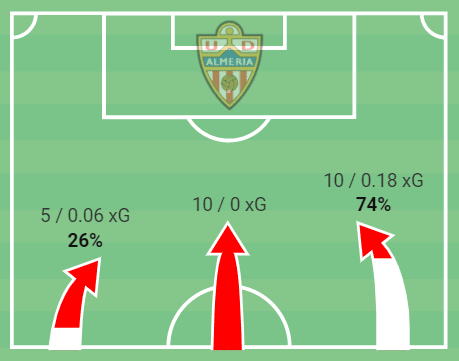
From these wide areas, Almeria try to cross the ball towards Umar who has one of the highest numbers of headed goals in the Segunda Division this season, or else they look to play deep completions from the edge of the box.
Almeria also have one of the highest deep completion rates in the league, averaging 7.62 per 90 with the division’s average currently standing at 4.49 as of writing.
Movement between the lines
However, a good quantity of their attacks come through the middle, but these tend to be a bit more direct from balls in behind to Umar or to one of the wide players making a diagonal run.
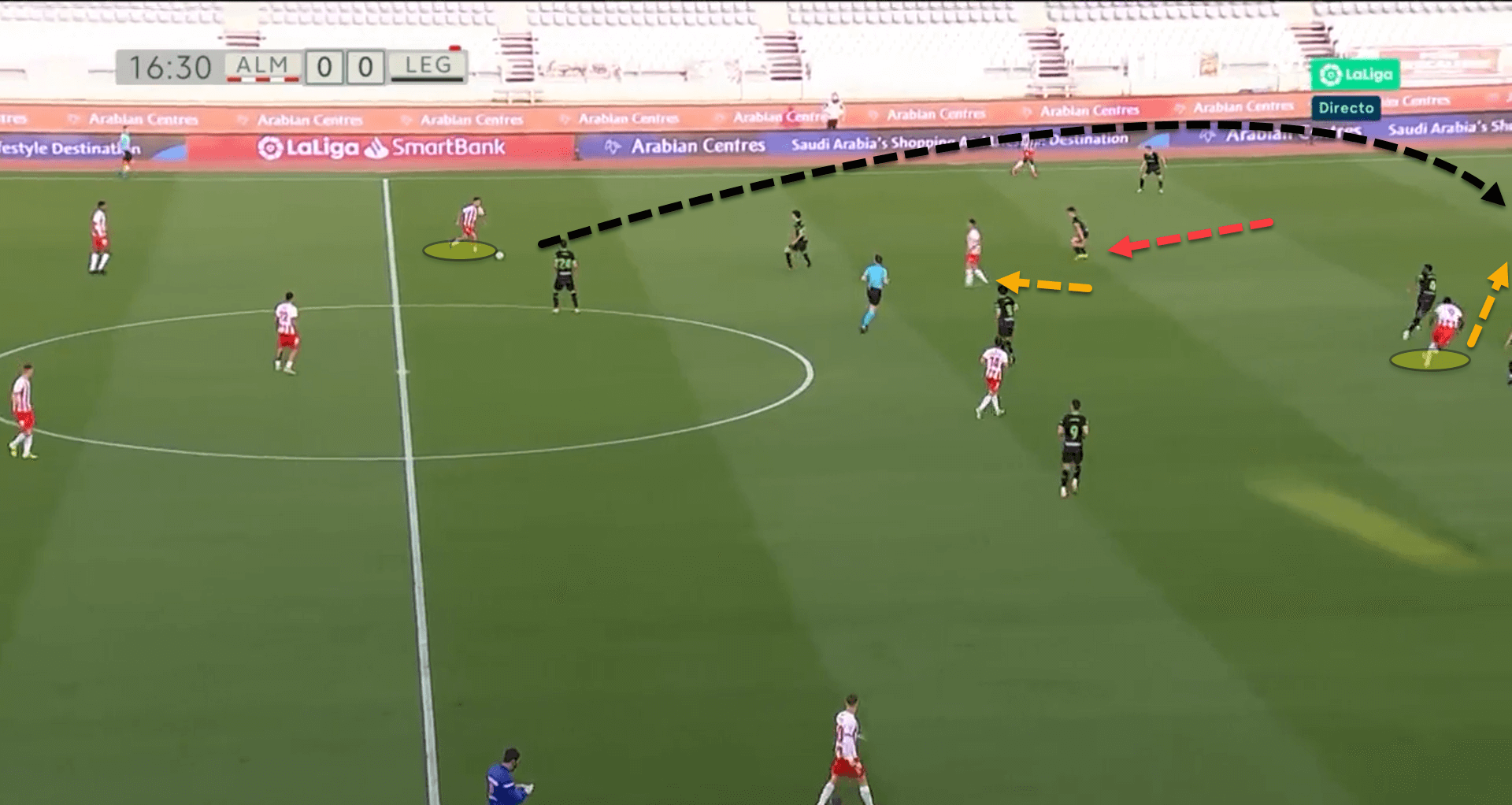
In the image above we can see Umar making a run in behind the Leganes deep defensive block, to be picked out by Morlanes. Nonetheless, it is not just Umar’s run in behind which creates an excellent chance for progression to the final third, but the slight movement of the other players between the lines.
Gomes likes to have at least three to four players between the opposition’s defensive line and midfield line when they are in a positional attack, which constantly gives them a numerical advantage in the centre of the pitch.
In this area, players are constantly dropping to receive and making runs in behind, sometimes consecutively in order to create space. In the previous image, the winger has dropped short in between the lines, which has pulled one of the centre-backs out of position, leaving space for Umar to run into and exploit.
Having numerous players between the opposition’s lines creating angles helps make ball progression much easier as there is always a line-splitting passing option to pass to further up the pitch.
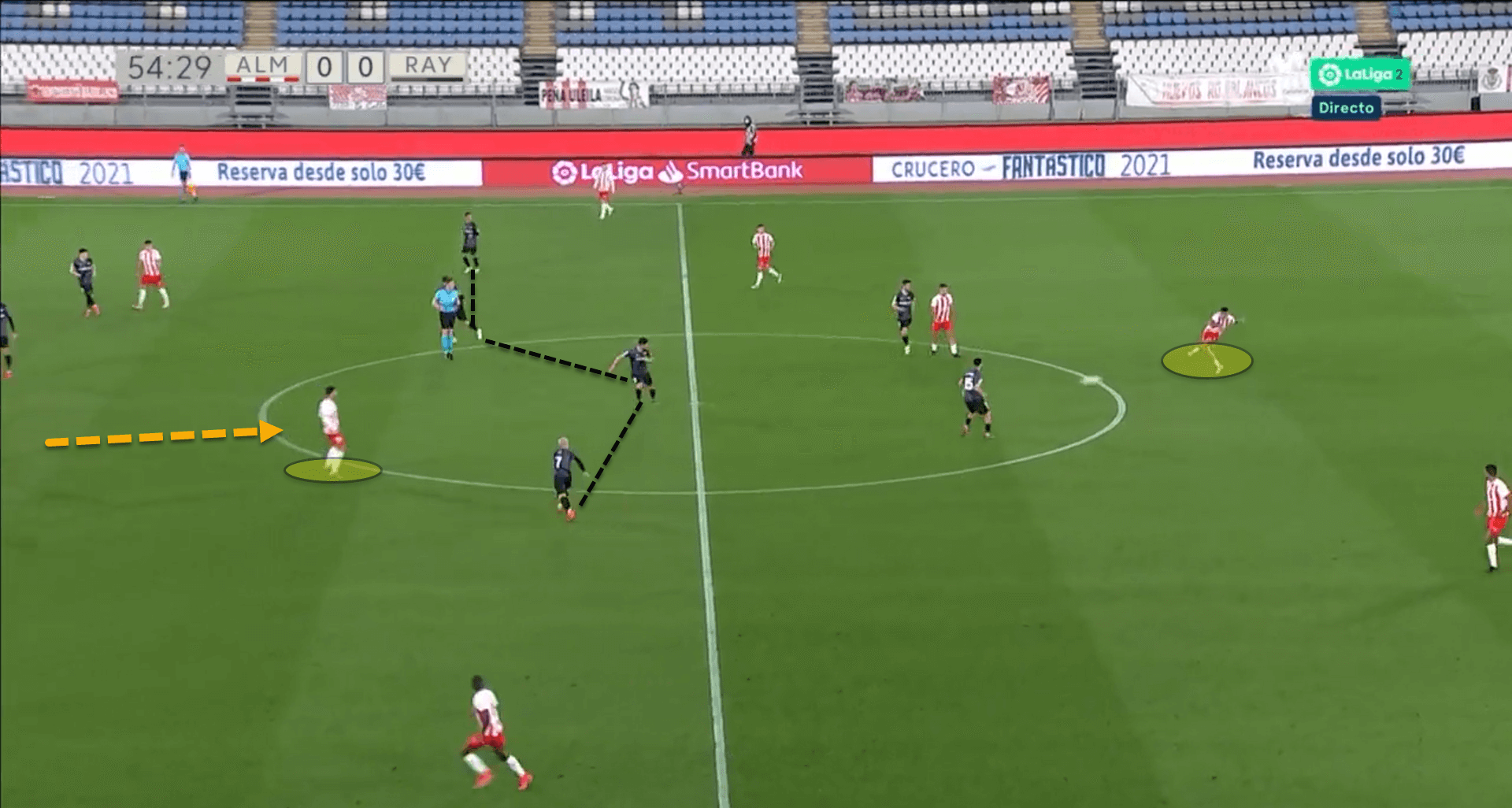
End product
Almeria tend not to cross the ball much and prefer to play through balls in behind instead. In fact, Gomes’ side currently has played the highest number of through passes per 90 in the division with 8.98, whilst also boasting the second-highest average number of key passes per 90 with 3.09.
However, this does not mean that they don’t cross the ball, but just that they opt to find alternatives first. Almeria have averaged 12.06 crosses to the box per 90 with an accuracy of 30.8 percent. 12.4 percent of these crosses have been to the six-yard box also.
The aim is typically always Umar as the Nigerian centre-forward stands at 6ft 3. The 24-year-old is destined for a move in the summer if Almeria fail to get promoted since he has had such an incredible season with La Union, currently boasting the second-highest goals and assists rate in the division with 17.74. Regardless, Corpas has also chipped in with quite a lot of goals, scoring 11 so far in the league alone this season as well as providing five assists. The pair have 34 goal contributions between them in actual goals and assists and are among the top five players for the most goal contributions this season.
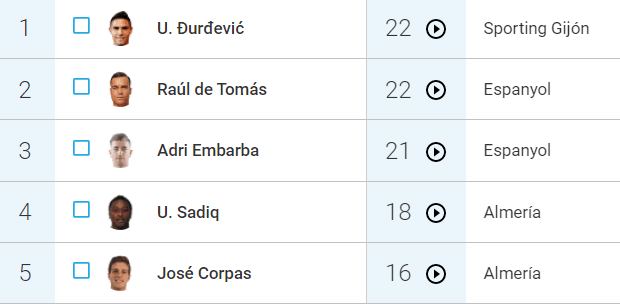
For this piece, we took a look at all of Almeria’s shots in all competitions from their previous ten games to get a sample of what kind of areas most of their shots were being taken from.
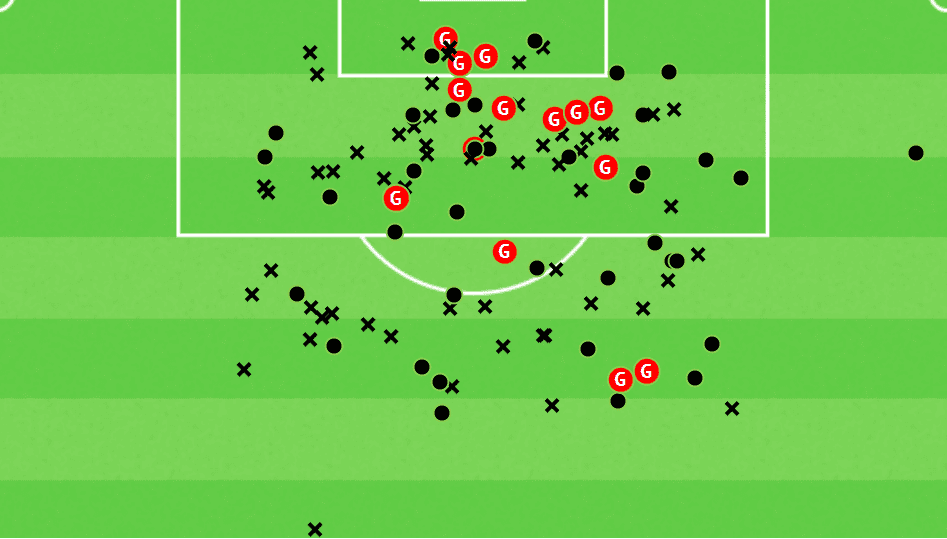
They take most of their shots from inside the penalty area as we can see from the data visual above with very few coming from inside the six-yard box. They do, however, take a large quantity of shots on goal from outside the area so Gomes has clearly given them orders to shoot if the players get themselves into solid positions on the pitch to do so.
Players such as Castro are quite efficient from these types of areas, which is why Gomes has given them license to do so.
Conclusion
Almeria are quite probably one of the most interesting teams to watch in Spanish football this season across all divisions and we would highly recommend trying to view one of their matches live, although this may be difficult due to the lack of television coverage for the Segunda Division.
La Union, under the guidance of Gomes, would be an excellent addition to La Liga, bringing an open and expansive style of football with a very enjoyable positional play structure to the league and they are certainly a team to watch out for in their battle for promotion this season.






Comments